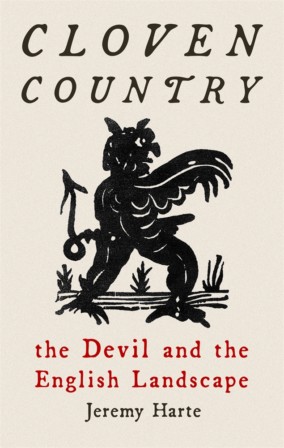Book Review: Cloven Country
You don’t have to travel far in Britain to find that the Devil has left his mark on the landscape. He has raised dykes, built bridges, causeways, and chimneys; left boulders, bolts, and dug ditches. He is the haunter of woods, the president of ghoulish feasts in graveyards. This is the territory, and its associated folklore explored by Jeremy Harte’s Cloven Country: The Devil and the English Landscape (Reaktion Books 2022, 296 pages, Hardback, illustrated).
The Devil of these sites and stories is not the all-powerful master of darkness; he is often easily discouraged or outwitted. An old woman with a candle, a clever cobbler, a schoolmaster with wizardly knowledge, and even a church choir – all foil the Devil’s attempted works. Sometimes a scholar or clergyman intervenes to rescue a tailor or smith who has, through their own hubris, made a bad bargain with the Devil. Hubris, idleness, and sometimes even words unwisely spoken can invite the Devil’s attention. Sometimes, it is a cunning man or clever magician who bests him at his games, and often, the magician is a parson or clergyman. Being able to read and write was often associated with unholy knowledge. Harte points out that for much of the 19th century, it was assumed that only an “Oxford scholar” could successfully lay a ghost to rest. Even a humble village schoolmaster could summon the Devil and compel him to perform a task, with the hope of escaping the dire consequences of such a pact. The Devil is particularly weak when he is challenged by women. Harte recounts a 17th-century tale in which the Devil is set upon and beaten up by three London fishwives.
Throughout Cloven Country, Harte demonstrates how folklore is layered, constantly rewoven, and remade. It does not spring forth from a single root; it is rhizomatic rather than arborescent. Whilst some of the legends concerning the activities of the devil are reworkings of earlier tales; many are of fairly recent origin, dating from the 17th century. Stories shift between locales; sometimes borrowed or stolen in the name of tourism. The Devil is good for business. Some stories are the invention of antiquarians; the “gentleman amateurs” who Harte says, recorded and rewrote the stories that have come down to us. Harte cautions us not to make assumptions about the antiquity of folklore. The stories of how the Devil made Silbury Hill, for example, he places as recently as the mid-19th century.
Harte’s meticulous scholarship shines through Cloven Country. There are some fascinating snippets of lore – for example, how church bells, in the Middle Ages, were baptized, and considered to be under the protection of the name of the saint they bore.
Accessible and written with verve and wit, Cloven Country is a rare treat for anyone with a love of British folklore. Backed up by thorough notes and bibliography, this book is a must for anyone interested in British folk magic, place-making, and the lore of the Devil.

